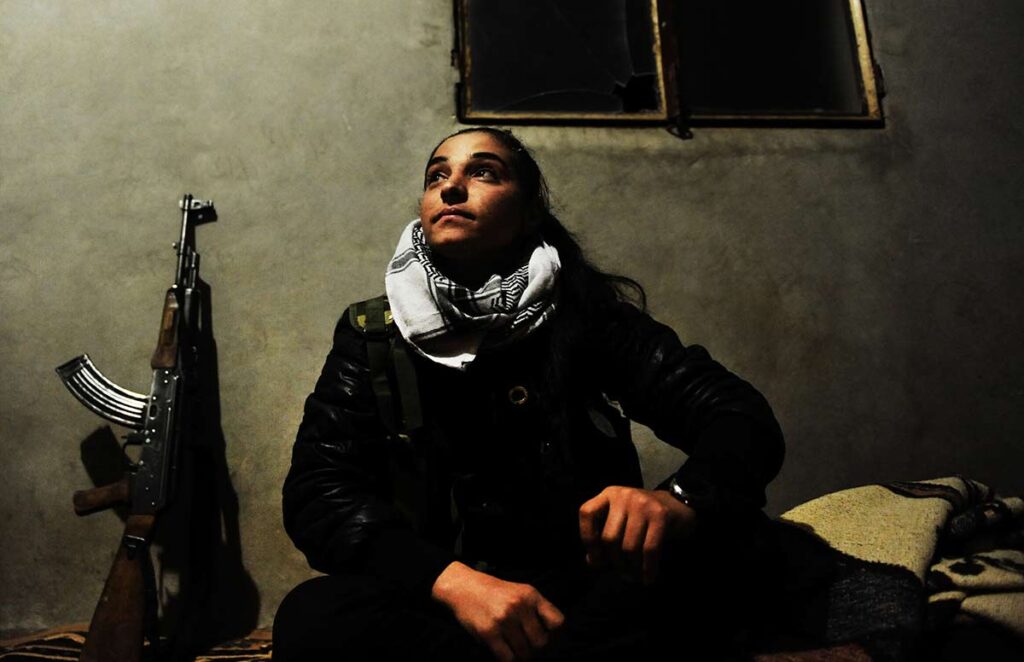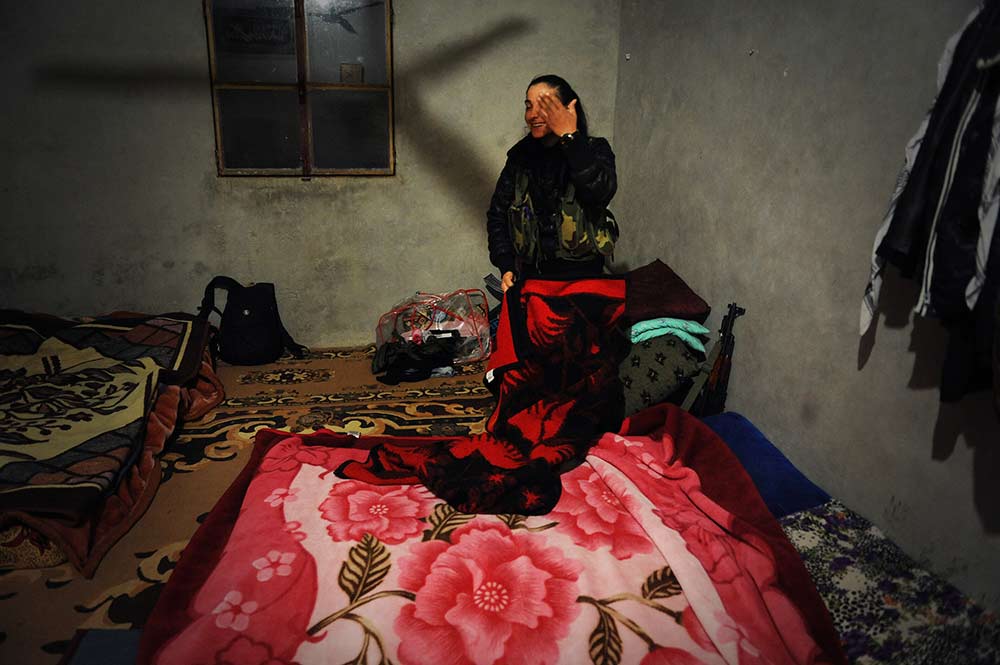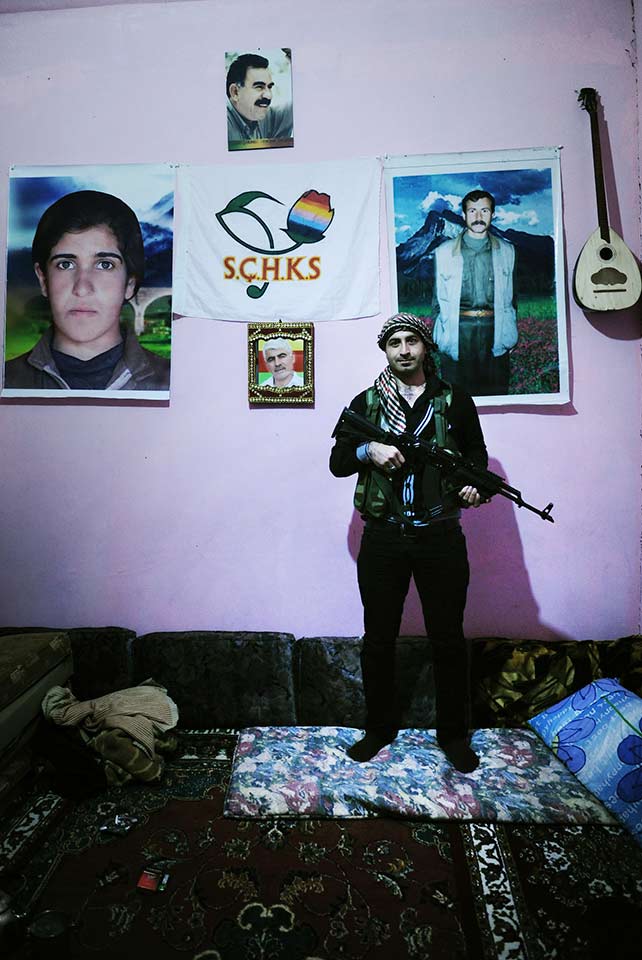AUDE OSNOWYCZ
Women fighters in Syria

Aude Osnowycz © All rights reserved.
WOMEN FIGHTERS IN SYRIA
The Kurdish people, known for their independence demands, have particularly distinguished themselves in the fight against Daesh. The capture of Raqqa in 2017, the capital of Daesh, was a symbol of this. At the heart of this struggle, women have always occupied a place. In support of combatants or arms in hand, they have decided to establish themselves as a recourse against the obscurantism of Daesh in order to rebuild, on the ashes of the Caliphate, a peaceful and equal society.
In the midst of chaos, the women of peace are on all fronts and are looking to the future. By arms or not, Kurdish women have always taken part in combat. Participating in the care of the wounded or supplying the forces engaged, some have chosen to take up arms.
In the 1960s, Margaret George Shello, a Christian peshmerga nicknamed the “mother of Kurdistan,” distinguished herself in the fight against the Iraqi government.
Gülnaz Karatas became an icon of the Kurdish feminist struggle by throwing herself off a cliff to avoid being captured … In their wake, female combatants from Rojava, a Syrian autonomous region, took part in the fight alongside the men. Initially integrated into the male units (YPG), female units were later established, such as the “women’s defense units” (YPJ).
“The fighting that is taking place is of the order of guerrilla warfare; it does not require any particular physical force,” says Sandrine Alexie of the Kurdish Institute in Paris. “Women, therefore, fulfill the same missions as men. They even have a reputation for making better snipers because they are more patient.” Beyond their ability to fight, Kurdish women have a powerful mental impact on Daesh fighters. They fear the death received at the hands of a woman, the ultimate torture. Against Daesh, Kurdish women are therefore a weapon of terror accompanied by wide-ranging communication, capable of shaping the legend. Fights and a commitment are highlighted by many artists.

Aude Osnowycz © All rights reserved.
The song “Revolution” performed by the Kurdish singer Helly Luv presents, in her video, the fight of Kurdish women against the Islamic State by displaying the slogan “stop the violence” to the sound of “Brothers and sisters we all come from one.”
A popular campaign to promote the committed action of female combatants in the service of the reconstruction of a more peaceful and egalitarian post-war society.
The end of the fighting means a return to civilian life for these women, who must then face new daily challenges. A return is often synonymous with precariousness for these women who have nevertheless acquired legitimacy in combat.

Aude Osnowycz © All rights reserved.
“Beyond the issue of armed combat and the Hollywood image of the female combatant, the war has left its mark on these Kurdish women. Many of them left their studies and their families to engage in the war against ISIS. Following the end of the fighting, many suffer from a lack of perspective for the future.
Social misery, economic dependence on men, physical mutilation, psychological suffering: the result of war is disastrous and often obscured by a combatant image, times a biased image of the combatant.” says Seve Aydin Izouli, a lawyer at the Paris bar association, President of the Damascus-France declaration.
These setbacks of the war thus pushed women to continue the fight, a peaceful fight in favor of the acquisition of new rights, which also led them to take an active part in the country’s reconstruction.


On the strength of their acquired legitimacy as combatants, Kurdish women were able to obtain new political responsibilities. “Things had changed since the 1990s when in Iraq, for example, Kurdish women occupied only 6 of the 105 parliamentary seats in the Kurdish regional parliament. […] today, quotas are in place. Women are thus well represented in parliamentary assemblies. In the regional parliament of Iraqi Kurdistan, one-third of the 111 seats are reserved for women. After 2008, in the government of Iraqi Kurdistan, there were 3 women out of 42 ministers; 40% of the elected representatives of Kongra-Gel (the Kurdish People’s Congress, parliament of the KCK, pro-PKK) are women, and the presidency of certain political bodies can be attributed to women,” explains Mélanie Dubuy, lecturer at the University of Lorraine. “Many women have reached leadership positions, including Ilham Ahmed, co-chair of the Syrian Democratic Council, Pervin Buldan, co-chair of the People’s Democratic Party (HDP), Vana Farid, provisional chair of the parliament of Iraqi Kurdistan or again Bayan Sami Abdul Al Rahman, Ambassador of the Kurdistan Regional Government to the United States.
They are present in number at the head of political parties and administrations. This would not have been possible without the legitimacy gained in combat over decades.” Emphasizes Seve Aydin Izouli.
Other women distinguished themselves not in politics but in diplomacy in order to influence the reconstruction and peace processes, like Colonel Nahida Rachid, who became a diplomat after her military career and her participation in the fighting over the years, and then against Daesh more recently.
Peace and reconstruction require a balance of responsibilities and respect for half of the population. Therefore, a change in mentality is vital but also very complex in an environment dominated by men and a culture in which women are hardly considered.

Leila Mustapha, the new mayor of Raqqa, must assert herself as a Kurd and as a woman. An engineer by training, she participates in changing attitudes to build a more egalitarian society.
“Under Daesh and before, under the Damascus regime, women and minorities were deeply discriminated against. It’s not that easy to change mentalities,” she explains. “It won’t come overnight. Changing mentalities will take years. And to conclude: If the woman is fulfilled in her responsibilities and her rights are respected, her family is happy, society is doing well and the country is enriched. ” says Leila Mustapha.
Abir Massoud, Kurdish director of a jihadist inmate prison, faces daily men steeped in radical Islamist ideology. Sure of her method of deradicalization, she now exhibits drawings of prisoners showing free women. “This unveiled woman carries a torch. It is a drawing donated by a prisoner, symbolizing a free woman.” … “The respect for women’s rights is carried here like a trophy showing the evolution of the mentality of these men won, for a time, by the ideology of Daesh.
A first victory.”

“Women are the key for solving many problems and must be more involved in building a lasting peace between communities. With the voice and participation of women, our society can change profoundly”. Claimed Nadia Murad, a prisoner of Daesh for several months, of Kurdish and Yazidi origin.
With courage, fear, conviction, and determination, these women have decided to invest relentlessly in building a society of tomorrow that they want peaceful and egalitarian. It is in this post-war society that female combatants continue their battles. With new weapons: education, politics, diplomacy, they intend to take their destiny in hand and trace this new path, still long, which will lead to peace.


Aude Osnowycz

Graduated with a master’s degree in geopolitics, Aude Osnowycz worked in various professions before turning to photography.
She decided in 2011 to become a photojournalist and moved to Tunisia. She spent four years documenting the impacts of the Arab Spring (in Tunisia, Egypt, Algeria, Iraq, Syria, Libya), particularly on issues related to minorities, women, and genre.
Osnowycz’s work has been published in numerous international magazines such as Le Monde, Marie Claire, GEO, OBS, The New York Times, Médiapart, the Guardian, Vanity fair, Newsweek, etc …
She has also exhibited her work at the phémina festival, RDVI, Barrob Objectif, Les Photographiques du Mans, and the Women Exposing themselves festival, chosen as the finalist for the Mentor Award and the Roger Pic Award.

Recently, she decided to start a long-term project focused on the post-Soviet universe. This more intimate work questions both the Slavic soul and her family’s past and reflects the gap between new and old generations, some carried by Soviet Putinian values the other by Western values. She also worked on the Putin generation in Russia, Belarusian exiles, and the militarization of children in the post-Soviet space. In general, she tries to paint a portrait of this gray area wedged between Russia and Europe, little covered by the media but of primary geostrategic importance.

